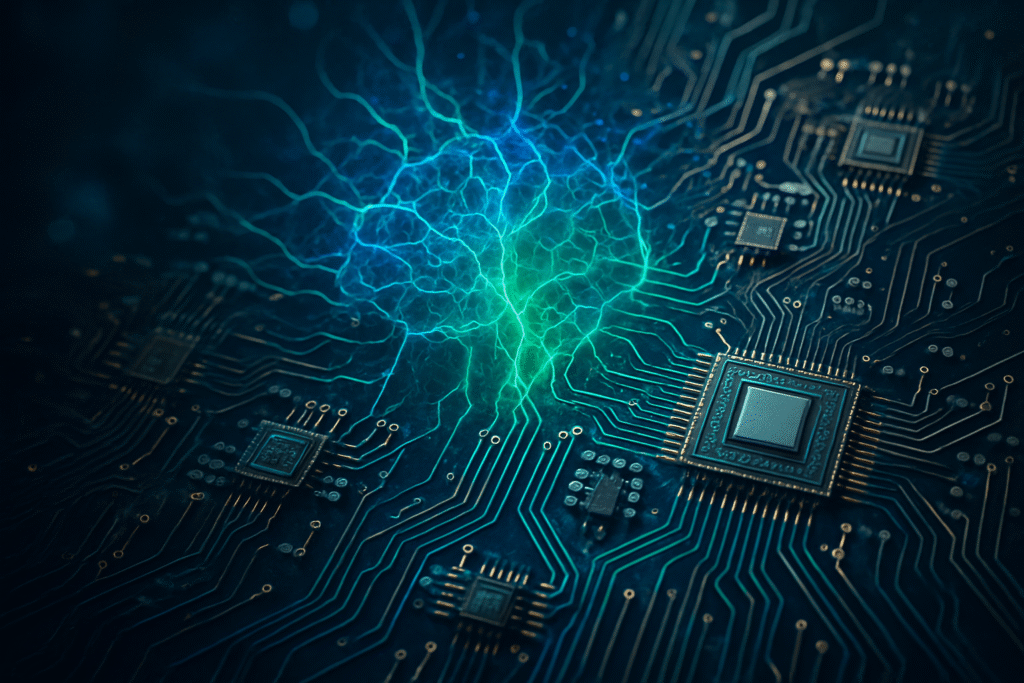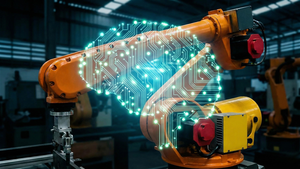
October 10, 2025 – Artificial Intelligence (AI) is no longer just a consumer of advanced semiconductors; it has become an indispensable architect and optimizer within the very industry that creates its foundational hardware. This symbiotic relationship is ushering in an unprecedented era of efficiency, innovation, and accelerated development across the entire semiconductor value chain. From the intricate labyrinth of chip design to the meticulous precision of manufacturing and the burgeoning field of specialized AI processors, AI's influence is profoundly reshaping the landscape, driving what some industry leaders are calling an "AI Supercycle."
The immediate significance of AI's pervasive integration lies in its ability to compress development timelines, enhance operational efficiency, and unlock entirely new frontiers in semiconductor capabilities. By automating complex tasks, predicting potential failures, and optimizing intricate processes, AI is not only making chip production faster and cheaper but also enabling the creation of more powerful and energy-efficient chips essential for the continued advancement of AI itself. This transformative impact promises to redefine competitive dynamics and accelerate the pace of technological progress across the global tech ecosystem.
AI's Technical Revolution: Redefining Chip Creation and Production
The technical advancements driven by AI in the semiconductor industry are multifaceted and groundbreaking, fundamentally altering how chips are conceived, designed, and manufactured. At the forefront are AI-driven Electronic Design Automation (EDA) tools, which are revolutionizing the notoriously complex and time-consuming chip design process. Companies like Synopsys (NASDAQ: SNPS) and Cadence (NASDAQ: CDNS) are pioneering AI-powered EDA platforms, such as Synopsys DSO.ai, which can optimize chip layouts, perform logic synthesis, and verify designs with unprecedented speed and precision. For instance, the design optimization cycle for a 5nm chip, which traditionally took six months, has been reportedly reduced to as little as six weeks using AI, representing a 75% reduction in time-to-market. These AI systems can explore billions of potential transistor arrangements and routing topologies, far beyond human capacity, leading to superior designs in terms of power efficiency, thermal management, and processing speed. This contrasts sharply with previous manual or heuristic-based EDA approaches, which were often iterative, time-intensive, and prone to suboptimal outcomes.
Beyond design, AI is a game-changer in semiconductor manufacturing and operations. Predictive analytics, machine learning, and computer vision are being deployed to optimize yield, reduce defects, and enhance equipment uptime. Leading foundries like Taiwan Semiconductor Manufacturing Company (NYSE: TSM) and Intel (NASDAQ: INTC) leverage AI for predictive maintenance, anticipating equipment failures before they occur and reducing unplanned downtime by up to 20%. AI-powered defect detection systems, utilizing deep learning for image analysis, can identify microscopic flaws on wafers with greater accuracy and speed than human inspectors, leading to significant improvements in yield rates, with potential reductions in yield detraction of up to 30%. These AI systems continuously learn from vast datasets of manufacturing parameters and sensor data, fine-tuning processes in real-time to maximize throughput and consistency, a level of dynamic optimization unattainable with traditional statistical process control methods.
The emergence of dedicated AI chips represents another pivotal technical shift. As AI workloads grow in complexity and demand, there's an increasing need for specialized hardware beyond general-purpose CPUs and even GPUs. Companies like NVIDIA (NASDAQ: NVDA) with its Tensor Cores, Google (NASDAQ: GOOGL) with its Tensor Processing Units (TPUs), and various startups are designing Application-Specific Integrated Circuits (ASICs) and other accelerators specifically optimized for AI tasks. These chips feature architectures tailored for parallel processing of neural network operations, offering significantly higher performance and energy efficiency for AI inference and training compared to conventional processors. The design of these highly complex, specialized chips itself often relies heavily on AI-driven EDA tools, creating a self-reinforcing cycle of innovation. The AI research community and industry experts have largely welcomed these advancements, recognizing them as essential for sustaining the rapid pace of AI development and pushing the boundaries of what's computationally possible.
Industry Ripples: Reshaping the Competitive Landscape
The pervasive integration of AI into the semiconductor industry is sending significant ripples through the competitive landscape, creating both formidable opportunities and strategic imperatives for established tech giants, specialized AI companies, and burgeoning startups. At the forefront of benefiting are companies that design and manufacture AI-specific chips. NVIDIA (NASDAQ: NVDA), with its dominant position in AI GPUs, continues to be a critical enabler for deep learning and neural network training, its A100 and H100 GPUs forming the backbone of countless AI deployments. However, this dominance is increasingly challenged by competitors like Advanced Micro Devices (NASDAQ: AMD), which offers powerful CPUs and GPUs, including its Ryzen AI Pro 300 series chips targeting AI-powered laptops. Intel (NASDAQ: INTC) is also making strides with high-performance processors integrating AI capabilities and pioneering neuromorphic computing with its Loihi chips.
Electronic Design Automation (EDA) vendors like Synopsys (NASDAQ: SNPS) and Cadence (NASDAQ: CDNS) are solidifying their market positions by embedding AI into their core tools. Their AI-driven platforms are not just incremental improvements; they are fundamentally streamlining chip design, allowing engineers to accelerate time-to-market and focus on innovation rather than repetitive, manual tasks. This creates a significant competitive advantage for chip designers who adopt these advanced tools. Furthermore, major foundries, particularly Taiwan Semiconductor Manufacturing Company (NYSE: TSM), are indispensable beneficiaries. As the world's largest dedicated semiconductor foundry, TSMC directly profits from the surging demand for cutting-edge 3nm and 5nm chips, which are critical for AI workloads. Equipment manufacturers such as ASML (AMS: ASML), with its advanced photolithography machines, are also crucial enablers of this AI-driven chip evolution.
The competitive implications extend to major tech giants and cloud providers. Companies like Amazon (NASDAQ: AMZN) (AWS), Google (NASDAQ: GOOGL), and Microsoft (NASDAQ: MSFT) are not merely consumers of these advanced chips; they are increasingly designing their own custom AI accelerators (e.g., Google's TPUs, AWS's Graviton and AI/ML chips). This strategic shift aims to optimize their massive cloud infrastructures for AI workloads, reduce reliance on external suppliers, and gain a distinct efficiency edge. This trend could potentially disrupt traditional market share distributions for general-purpose AI chip providers over time. For startups, AI offers a dual-edged sword: while cloud-based AI design tools can democratize access to advanced resources, lowering initial investment barriers, the sheer cost and complexity of developing and manufacturing cutting-edge AI hardware still present significant hurdles. Nonetheless, specialized startups like Cerebras Systems and Graphcore are attracting substantial investment by developing AI-dedicated chips optimized for specific machine learning workloads, proving that innovation can still flourish outside the established giants.
Wider Significance: The AI Supercycle and Its Global Ramifications
The increasing role of AI in the semiconductor industry is not merely a technical upgrade; it represents a fundamental shift that holds profound wider significance for the broader AI landscape, global technology trends, and even geopolitical dynamics. This symbiotic relationship, where AI designs better chips and better chips power more advanced AI, is accelerating innovation at an unprecedented pace, giving rise to what many industry analysts are terming the "AI Supercycle." This cycle is characterized by exponential advancements in AI capabilities, which in turn demand more powerful and specialized hardware, creating a virtuous loop of technological progress.
The impacts are far-reaching. On one hand, it enables the continued scaling of large language models (LLMs) and complex AI applications, pushing the boundaries of what AI can achieve in fields from scientific discovery to autonomous systems. The ability to design and manufacture chips more efficiently and with greater performance opens doors for AI to be integrated into virtually every aspect of technology, from edge devices to enterprise data centers. This democratizes access to advanced AI capabilities, making sophisticated AI more accessible and affordable, fostering innovation across countless industries. However, this rapid acceleration also brings potential concerns. The immense energy consumption of both advanced chip manufacturing and large-scale AI model training raises significant environmental questions, pushing the industry to prioritize energy-efficient designs and sustainable manufacturing practices. There are also concerns about the widening technological gap between nations with advanced semiconductor capabilities and those without, potentially exacerbating geopolitical tensions and creating new forms of digital divide.
Comparing this to previous AI milestones, the current integration of AI into semiconductor design and manufacturing is arguably as significant as the advent of deep learning or the development of the first powerful GPUs for parallel processing. While earlier milestones focused on algorithmic breakthroughs or hardware acceleration, this development marks AI's transition from merely consuming computational power to creating it more effectively. It’s a self-improving system where AI acts as its own engineer, accelerating the very foundation upon which it stands. This shift promises to extend Moore's Law, or at least its spirit, into an era where traditional scaling limits are being challenged. The rapid generational shifts in engineering and manufacturing, driven by AI, are compressing development cycles that once took decades into mere months or years, fundamentally altering the rhythm of technological progress and demanding constant adaptation from all players in the ecosystem.
The Road Ahead: Future Developments and the AI-Powered Horizon
The trajectory of AI's influence in the semiconductor industry points towards an accelerating future, marked by increasingly sophisticated automation and groundbreaking innovation. In the near term (1-3 years), we can expect to see further enhancements in AI-powered Electronic Design Automation (EDA) tools, pushing the boundaries of automated chip layout, performance simulation, and verification, leading to even faster design cycles and reduced human intervention. Predictive maintenance, already a significant advantage, will become more sophisticated, leveraging real-time sensor data and advanced machine learning to anticipate and prevent equipment failures with near-perfect accuracy, further minimizing costly downtime in manufacturing facilities. Enhanced defect detection using deep learning and computer vision will continue to improve yield rates and quality control, while AI-driven process optimization will fine-tune manufacturing parameters for maximum throughput and consistency.
Looking further ahead (5+ years), the landscape promises even more transformative shifts. Generative AI is poised to revolutionize chip design, moving towards fully autonomous engineering of chip architectures, where AI tools will independently optimize performance, power consumption, and area. AI will also be instrumental in the development and optimization of novel computing paradigms, including energy-efficient neuromorphic chips, inspired by the human brain, and the complex control systems required for quantum computing. Advanced packaging techniques like 3D chip stacking and silicon photonics, which are critical for increasing chip density and speed while reducing energy consumption, will be heavily optimized and enabled by AI. Experts predict that by 2030, AI accelerators with Application-Specific Integrated Circuits (ASICs) will handle the majority of AI workloads due to their unparalleled performance for specific tasks.
However, this ambitious future is not without its challenges. The industry must address issues of data scarcity and quality, as AI models demand vast amounts of pristine data, which can be difficult to acquire and share due to proprietary concerns. Validating the accuracy and reliability of AI-generated designs and predictions in a high-stakes environment where errors are immensely costly remains a significant hurdle. The "black box" problem of AI interpretability, where understanding the decision-making process of complex algorithms is difficult, also needs to be overcome to build trust and ensure safety in critical applications. Furthermore, the semiconductor industry faces persistent workforce shortages, requiring new educational initiatives and training programs to equip engineers and technicians with the specialized skills needed for an AI-driven future. Despite these challenges, the consensus among experts is clear: the global AI in semiconductor market is projected to grow exponentially, fueled by the relentless expansion of generative AI, edge computing, and AI-integrated applications, promising a future of smarter, faster, and more energy-efficient semiconductor solutions.
The AI Supercycle: A Transformative Era for Semiconductors
The increasing role of Artificial Intelligence in the semiconductor industry marks a pivotal moment in technological history, signifying a profound transformation that transcends incremental improvements. The key takeaway is the emergence of a self-reinforcing "AI Supercycle," where AI is not just a consumer of advanced chips but an active, indispensable force in their design, manufacturing, and optimization. This symbiotic relationship is accelerating innovation, compressing development timelines, and driving unprecedented efficiencies across the entire semiconductor value chain. From AI-powered EDA tools revolutionizing chip design by exploring billions of possibilities to predictive analytics optimizing manufacturing yields and the proliferation of dedicated AI chips, the industry is experiencing a fundamental re-architecture.
This development's significance in AI history cannot be overstated. It represents AI's maturation from a powerful application to a foundational enabler of its own future. By leveraging AI to create better hardware, the industry is effectively pulling itself up by its bootstraps, ensuring that the exponential growth of AI capabilities continues. This era is akin to past breakthroughs like the invention of the transistor or the advent of integrated circuits, but with the unique characteristic of being driven by the very intelligence it seeks to advance. The long-term impact will be a world where computing is not only more powerful and efficient but also inherently more intelligent, with AI embedded at every level of the hardware stack, from cloud data centers to tiny edge devices.
In the coming weeks and months, watch for continued announcements from major players like NVIDIA (NASDAQ: NVDA), Intel (NASDAQ: INTC), and AMD (NASDAQ: AMD) regarding new AI-optimized chip architectures and platforms. Keep an eye on EDA giants such as Synopsys (NASDAQ: SNPS) and Cadence (NASDAQ: CDNS) as they unveil more sophisticated AI-driven design tools, further automating and accelerating the chip development process. Furthermore, monitor the strategic investments by cloud providers like Google (NASDAQ: GOOGL) and Amazon (NASDAQ: AMZN) in their custom AI silicon, signaling a deepening commitment to vertical integration. Finally, observe how geopolitical dynamics continue to influence supply chain resilience and national initiatives aimed at fostering domestic semiconductor capabilities, as the strategic importance of AI-powered chips becomes increasingly central to global technological leadership. The AI-driven semiconductor revolution is here, and its impact will shape the future of technology for decades to come.
This content is intended for informational purposes only and represents analysis of current AI developments.
TokenRing AI delivers enterprise-grade solutions for multi-agent AI workflow orchestration, AI-powered development tools, and seamless remote collaboration platforms.
For more information, visit https://www.tokenring.ai/.






